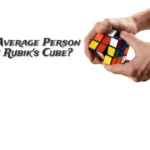The Rubik’s Cube, with its colorful and puzzling appearance, has intrigued and challenged people for decades. It is a symbol of both nostalgia and intellectual pursuit. While many are content with solving it, some seek a deeper understanding of this iconic puzzle by disassembling it. In this article, we will guide you through the step-by-step process of how to disassemble a Rubik’s Cube and explore the inner workings of this deceptively complex puzzle. Understanding these intricacies can not only aid in cube maintenance but also open the door to customization and modification.
Tools and Materials
Before you start your Rubik’s Cube disassembling journey, it’s essential to gather the necessary tools and materials:
1. Rubik’s Cube: The star of the show – the cube itself.
2. Screwdriver: To access the cube’s core.
3. Small Container: A safe place to store the cube’s parts during disassembly.
4. Lubricant (Optional): If you plan to maintain or customize your cube.
Precautions
Disassembling a Rubik’s Cube requires care and precision. Here are some precautions to keep in mind:
1. **Work on a Flat Surface**: Use a clean, flat surface to prevent small parts from rolling away.
2. **Be Gentle**: Avoid using excessive force; the cube is delicate.
3. **Organize Parts**: Use a small container to keep the pieces organized during disassembly.
How to Disassemble a Rubik’s Cube?
Remove the Center Cap

Start by removing the center cap on one face of the cube. This cap conceals the screw you need to access. Use a flat tool or fingernail to gently pry off the center cap without damaging it.
Access the Screw
Once the center cap is removed, you’ll see the screw underneath. This screw holds the cube together and is a vital part of the disassembly process. Take a moment to examine its location.
Unscrew the Cube
Using a screwdriver, carefully turn the screw counterclockwise to loosen it. Be cautious not to overtighten or strip the screw. As you unscrew, you will notice that the cube’s layers begin to separate.
Separate the Pieces
As you continue to unscrew, the cube will come apart into its core and individual pieces. You can now remove the center pieces, edge pieces, and corner pieces. Handle these pieces gently, as they can be easily damaged.
Collect and Organize the Parts
To ensure you don’t lose any parts, place them in a small container or on a clean, flat surface. This step is crucial, especially if you plan to reassemble the cube later.
Understanding the Cube’s Inner Mechanism
Now that you have successfully disassembled your Rubik’s Cube, it’s time to explore the inner mechanism of this enigmatic puzzle.
Components of the Rubik’s Cube
1. Core
The core is the cube’s central structure, and the screw you removed is an integral part of it. It holds the cube together and provides stability.
2. Center Pieces
Each face of the Rubik’s Cube has a centerpiece. These pieces do not move and serve as a reference point for the cube’s solving process. The center pieces determine the color of each face.
3. Edge Pieces
Edge pieces are located between the center and corner pieces. These are the parts that you can rotate to create different combinations of colors on the cube’s faces.
4. Corner Pieces
The corner pieces are situated at the corners of the cube. They are vital for changing the orientation of the colors on the cube.
How the Cube Functions
The Rubik’s Cube functions based on a unique mechanism. When you rotate an edge or corner piece, you are essentially moving it around the cube’s core. This movement allows the cube to change its configuration, presenting a new puzzle to solve.
The Cube’s Design and Solving Mechanism
The Rubik’s Cube is designed to be a perplexing three-dimensional puzzle. The challenge lies in restoring each face of the cube to its original, single-color state. Solving the cube involves understanding the relationships between the center, edge, and corner pieces and using precise sequences of moves to rearrange them.
Maintenance and Lubrication
To keep your Rubik’s Cube in top-notch condition, here are some maintenance tips:
Cleaning
Regularly clean the cube’s pieces with a mild soap and water solution to remove dirt and residue. Avoid using harsh chemicals or abrasive materials.
Lubrication (Optional)
Lubrication can significantly improve the cube’s performance, making it smoother and easier to manipulate. Apply a small amount of specialized cube lubricant to the core before reassembling the cube. This step is optional but can enhance your solving experience.
Reassembling the Cube
To put your Rubik’s Cube back together:
- Follow the steps of disassembly in reverse order.
- Carefully place the pieces back in their original positions and tighten the screw.
- Test the cube’s movement to ensure it’s functioning correctly.
Tension Adjustment
If you find the cube’s movement too tight or loose, you can adjust the tension by carefully loosening or tightening the screw. Finding the perfect tension is a matter of personal preference.
Conclusion
Disassembling a Rubik’s Cube can be an enlightening experience that deepens your appreciation for this iconic puzzle. Understanding the cube’s inner workings not only facilitates maintenance but also opens the door to customization and modifications. Remember always to handle the cube with care and precision, and you’ll be on your way to mastering this enigmatic three-dimensional challenge. Whether you’re an aspiring speedcuber or simply a Rubik’s Cube enthusiast, the knowledge gained from this process can enhance your experience and open up a world of creative possibilities. So, pick up your cube, embark on your disassembly journey, and unlock the secrets within.




